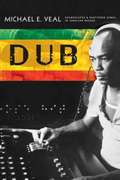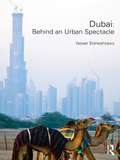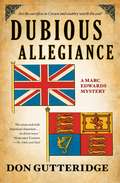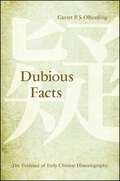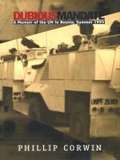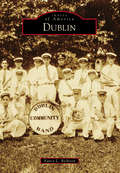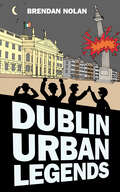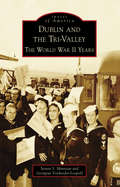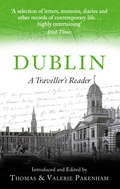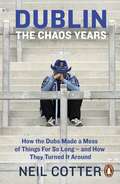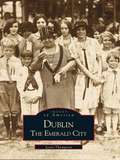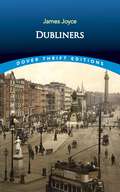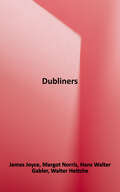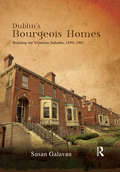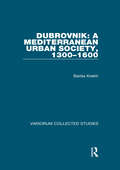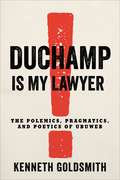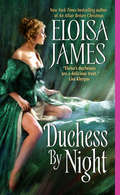- Table View
- List View
Duarte Chronicles (American Chronicles)
by Alan Heller Claudia HellerAndres Duarte was a Mexican army veteran who was awarded a 6,595-acre grant south of the San Gabriel Mountains in 1841. Parceled out to settlers and farmers, the Rancho Azusa de Duarte began thriving when rail lines were built to access the citrus crops. Duarte was home to the City of Hope, a tuberculosis clinic that became a world-class cancer research and treatment center. The old U.S. Route 66 brought thousands of new Californians through the residential melting pot from points east. Residents have included such notables as big-band leader Glenn Miller and playwright Sam Shepard. Join coauthors Claudia and Alan Heller as they recall the people, institutions, events and natural elements that have made Duarte a unique Los Angeles County city.
Dub
by Michael VealWhen Jamaican recording engineers Osbourne "King Tubby" Ruddock, Errol Thompson, and Lee "Scratch" Perry began crafting "dub" music in the early 1970s, they were initiating a musical revolution that continues to have worldwide influence. Dub is a sub-genre of Jamaican reggae that flourished during reggae's "golden age" of the late 1960s through the early 1980s. Dub involves remixing existing recordings--electronically improvising sound effects and altering vocal tracks--to create its unique sound. Just as hip-hop turned phonograph turntables into musical instruments, dub turned the mixing and sound processing technologies of the recording studio into instruments of composition and real-time improvisation. In addition to chronicling dub's development and offering the first thorough analysis of the music itself, author Michael Veal examines dub's social significance in Jamaican culture. He further explores the "dub revolution" that has crossed musical and cultural boundaries for over thirty years, influencing a wide variety of musical genres around the globe.Ebook Edition Note: Seven of the 25 illustrations have been redacted.
Dubai: Behind an Urban Spectacle (Planning, History and Environment Series)
by Yasser ElsheshtawyYasser Elsheshtawy explores Dubai’s history from its beginnings as a small fishing village to its place on the world stage today, using historical narratives, travel descriptions, novels and fictional accounts by local writers to bring colour to his history of the city’s urban development. With the help of case studies and surveys this book explores the economic and political forces driving Dubai’s urban growth, its changing urbanity and its place within the global city network. Uniquely, it looks beyond the glamour of Dubai’s mega-projects, and provides an in-depth exploration of a select set of spaces which reveal the city’s ‘inner life’.
Dubious Allegiance
by Don GutteridgeAutumn 1837: the provinces of Upper and Lower Canada are on the eve of open revolt. Lieutenant Marc Edwards has been sent with a force of British soldiers to subdue the increasingly hostile French rebels. But as the smoke from the battle clears and political pressures build, Marc begins to question whether the sacrifices he has made in the name of Crown and country have been worth the cost. On his return trip to Toronto, Marc is accompanied by a group of seemingly innocent civilians. But as tensions in the provinces escalate and personal grievances within the group arise, it becomes clear that not everyone Marc is traveling with is who he appears to be. Soon, mysterious death threats are issued and Marc finds himself the target of an unknown assassin. And when a member of the group is found murdered in the woods, Marc realizes that he may have more than one killer to worry about.
Dubious Facts: The Evidence of Early Chinese Historiography (SUNY series in Chinese Philosophy and Culture)
by Garret P. OlberdingWhat were the intentions of early China's historians? Modern readers must contend with the tension between the narrators' moralizing commentary and their description of events. Although these historians had notions of evidence, it is not clear to what extent they valued what contemporary scholars would deem "hard" facts. Offering an innovative approach to premodern historical documents, Garret P. S. Olberding argues that the speeches of court advisors reveal subtle strategies of information management in the early monarchic context. Olberding focuses on those addresses concerning military campaigns where evidence would be important in guiding immediate social and political policy. His analysis reveals the sophisticated conventions that governed the imperial advisor's logic and suasion in critical state discussions, which were specifically intended to counter anticipated doubts. Dubious Facts illuminates both the decision-making processes that informed early Chinese military campaigns and the historical records that represent them.
Dubious Mandate: A Memoir of the UN in Bosnia, Summer 1995
by Phillip CorwinA critical year in the history of peacekeeping, 1995 saw the dramatic transformation of the role of United Nations' forces in Bosnia from a protective force to being an active combatant under NATO leadership. Phillip Corwin, the UN's chief political officer in Sarajevo during the summer of that year, presents an insider's account of the momentous events that led to that transformation. Dubious Mandate interweaves personal experiences of daily life in a war zone--supply shortages, human suffering, assassination attempts, corruption--with historical facts, as Corwin challenges commonly held views of the war with his own highly informed, discerning, and trenchant political commentary. Sympathetic to the UN's achievements, yet skeptical of its acquiescence to the use of military force, Corwin is critical both of the Bosnian government's tactics for drawing NATO into the conflict and of NATO's eagerness to make peace by waging war. He challenges the popular depiction of the Bosnian government as that of noble victim, arguing that the leaders of all three sides in the conflict were "gangsters wearing coats and ties." Highly caustic about Western reportage, he examines the policies of various Western political and military leaders and gives a detailed account of a pivotal phase of the war in Bosnia, a period that culminated with NATO's massive bombing of Bosnian Serb targets and ultimately led to the Dayton Peace Agreement. Without a proper understanding of this critical period, he argues, it is difficult to understand the greater scope of the conflict. Corwin also offers insightful portraits of some of the leading players in the Bosnian drama, including Yasushi Akashi, the UN's top official in the former Yugoslavia in 1994-95; General Rupert Smith, the British commander in Sarajevo in 1995; and Hasan Muratovic, a future Bosnian prime minister. Capturing the essence of a tense and difficult time, Dubious Mandate will interest diplomats, politicians, military personnel, scholars, and those still trying to fathom the continuing mission of the United Nations and the unfolding of events in the former Yugoslavia during the 1990s.
Dublin (Images of America)
by Mike Lynch Dublin Heritage CenterNestled in the wooded hills east of the San Francisco Bay, Dublin's sprawling valley has welcomed people from a variety of backgroundsthroughout its rich history. At the heart of the tri-valley region, this former agricultural area has grown exponentially over the years, forming a moderncity with a solid community-oriented heritage. From California's first native inhabitants, through the Spanish and Mexican periods, to the arrival of the first American settlers, Dublin has long been at the crossroads of culture and settlement.
Dublin (Images of America)
by Nancy L. RichisonThroughout history, the city of Dublin's rich, verdant land has attracted settlers and visitors alike. Native Americans first inhabited the area in the days before the US government gave Continental Army soldiers property along the banks of the Scioto River as payment for service in the Revolutionary War. Platted as a village in 1810, Dublin's early settlers included John Sells, who offered surveyor John Shields the privilege of naming the new settlement. Legend has it that the lush vegetation prompted Shields to bestow the name of his homeland: Dublin, Ireland. Dublin, Ohio, would remain a sleepy little burg until the 1960s and 1970s, when three major changes led to explosive growth: the construction of Interstate 270, the development of Jack Nicklaus's Muirfield Village Golf Club and residential neighborhood, and the arrival of Ashland, Inc. Today, Dublin is known as a golf mecca--home of the PGA Tour's Memorial Tournament--and an international corporate headquarters, with The Wendy's Company, Stanley Steemer, and Cardinal Health among its marquee businesses.
Dublin Urban Legends
by Brendan NolanWho stole the Irish crown jewels? Is there a secret tunnel in O’Connell Street? And did the word ‘quiz’ originate in Dublin as the result of a bet? Urban legends are the funny and frightening folklore people share today. Just like the early folk tales that came before them, these tales are formed from reactions to events in the modern world, and reflect our current values. For the first time, Brendan Nolan explores the power of Dublin’s urban legend – murky stories whispered in classrooms and back streets, and ripping yarns passed on across the bar. Urban legends may be just exaggerated rumours, but they embed themselves into local folklore. The real question is, what truth lies behind them?
Dublin and the Tri-Valley: The World War II Years (Images of America)
by Steven S. Minniear Georgean Vonheeder-LeopoldIn 1941, the Navy sought West Coast locations for bases to ship men, material, and equipment into World War II's Pacific theater. The Dublin and Livermore area offered wide-open spaces with good transportation routes to the San Francisco Bay area. Near Dublin, the Navy built Camp Parks, Camp Shoemaker, and Shoemaker Naval Hospital. Camp Parks prepared Seabees to build and maintain airfields, ports, and hospitals from Guadalcanal to Japan. Hundreds of thousands of other sailors and WAVES came to Camp Shoemaker on their way from basic training to postings on ships, bases, and stations throughout the Pacific. Shoemaker Hospital saw them again when they returned injured or ill. Farther east, the Navy built Livermore Naval Air Station to train thousands to fly.
Dublin's Great Wars: The First World War, the Easter Rising and the Irish Revolution
by Professor Richard S. GraysonFor the first time, Richard S. Grayson tells the story of the Dubliners who served in the British military and in republican forces during the First World War and the Irish Revolution as a series of interconnected 'Great Wars'. He charts the full scope of Dubliners' military service, far beyond the well-known Dublin 'Pals', with at least 35,000 serving and over 6,500 dead, from the Irish Sea to the Middle East and beyond. Linking two conflicts usually narrated as separate stories, he shows how Irish nationalist support for Britain going to war in 1914 can only be understood in the context of the political fight for Home Rule and why so many Dubliners were hostile to the Easter Rising. He examines Dublin loyalism and how the War of Independence and the Civil War would be shaped by the militarisation of Irish society and the earlier experiences of veterans of the British army.
Dublin: A Traveller's Reader
by Thomas Pakenham Valerie Pakenham'Unforgettable . . . no better compilers could have been found' - History Today'Dublin's past comes dazzlingly alive' - Publishing News'Erudite and practical simultaneously' - Gemma Hussey, Irish IndependentDublin's turbulent history, its intensely literary and theatrical character of long literary lineage, its revolutionary ideals and heroes, and its ordinary life are all brought to life in this collection of letters, diaries and memoirs of travellers to the city and by Dubliners themselves. The extracts, from medieval times onwards, include Red Hugh O'Donnell's escape from Dublin Castle, James Joyce's plans for a novel while staying at the Martello Tower, and the seizure of the GPO by Irish volunteers during the Easter Rising. The book also includes gossip and story-telling in the humorous sketches of many famous Dubliners.
Dublin: How the Dubs Made a Mess of Things for So Long – and How They Turned It Around
by Neil CotterIrish Times Sports Book of the Year Dublin has become the dominant force in Gaelic football, setting new standards of skill and efficiency. But it was not very long ago that the county was a byword for underachievement and disorganization. Every year from 1996 to 2010, the Dubs found new and creative ways of losing, of causing their fans to suffer, and of earning the scorn of the wider GAA public.Based on interviews with former players and coaches, Dublin: The Chaos Years tells the entertaining and sometimes scarcely believable story of how the Dubs managed to make such a hames of things over a period of fifteen years. It also traces the beginnings of the turnaround, as the bad habit of failure began to give way to a healthier culture. Full of frank, witty and sometimes outrageous stories and analysis from the people who were at the centre of it, Dublin: The Chaos Years is a book for every Gaelic football fan.'Fascinating' Kieran Cunningham, Irish Daily Star'This book offers fascinating insight into the egos, dressing room divides, and bad habits which held the county back on the field. ... [It's] full of honest and witty interviews with players, coaches and officials from that revolutionary period.' Darren Frehil, RTÉ Culture'From unwelcoming veterans to arseboxing and collapsing human pyramids to marching to the Hill to startled earwigs to champs, Cotter has it all covered in a very well-written and insightful read.' Kieran Shannon, Irish Examiner'Cotter has done some terrific interviews ... the raw, hard-nosed nature of the Dublin dressing room at the end of the 1990s jumps from the page. ... Well worth anyone's time' Malachy Clerkin, Irish Times Sports Books of 2018
Dublin: The Emerald City (Images of America)
by Scott ThompsonAt the dawn of the twentieth century, Dublin, Georgia, was transformed from a violent and lawless community into one of the state's fastest growing, most prosperous and cultivated cities. The coming of the railroad, the prohibition of liquor sales, and evolving industries all played a part in escortingDublin into this "Golden Era," a period of unparalleled expansion and exuberance. With over two hundred historic photographs, Dublin: The Emerald City takes the reader on a journey into Dublin's storied past, tracing the major events that gave Dublin its sense of community and restored pride in its residents following years of turmoil. Included are images of the town's early homes, businesses, churches, and schools, as well as local festivals, fairs, and sports teams. Although the town's Golden Era came to an untimely end with the invasion of the boll weevil, the influenza epidemic of 1918, and the devastation of lives lost during the First World War, Dublin is still a spirited community, growing and changing with the times while reflecting upon a colorful history.
Dublin: The Making of a Capital City
by David DicksonAs rich and diverse as its subject, Dickson's magisterial history brings 1,400 years of Dublin vividly to life: from its medieval incarnation through the neoclassical eighteenth century, the Easter Rising that convulsed the city in 1916, the bloody civil war following the handover of power by Britain, to end-of-millennium urban renewal efforts.
Dubliners
by James JoyceAlthough James Joyce began these stories of Dublin life in 1904, when he was 22, and had completed them by the end of 1907, they remained unpublished until 1914 — victims of Edwardian squeamishness. Their vivid, tightly focused observations of the life of Dublin's poorer classes, their unconventional themes, coarse language, and mention of actual people and places made publishers of the day reluctant to undertake sponsorship.Today, however, the stories are admired for their intense and masterly dissection of "dear dirty Dublin," and for the economy and grace with which Joyce invested this youthful fiction. From "The Sisters," the first story, illuminating a young boy's initial encounter with death, through the final piece, "The Dead," considered a masterpiece of the form, these tales represent, as Joyce himself explained, a chapter in the moral history of Ireland that would give the Irish "one good look at themselves." But in the end the stories are not just about the Irish; they represent moments of revelation common to all people.Now readers can enjoy all 15 stories in this inexpensive collection, which also functions as an excellent, accessible introduction to the work of one of the 20th century's most influential writers. Dubliners is reprinted here, complete and unabridged, from a standard edition.
Dubliners: A Norton Critical Edition
by James Joyce Margot Norris Hans Walter Gabler Walter HettcheDubliners is arguably the best-known and most influential collection of short stories written in English and has been since its publication in 1914. Through what Joyce described as their "style of scrupulous meanness," the stories present a direct, sometimes searing view of Dublin in the early twentieth century. The text of this Norton Critical Edition is based on renowned Joyce scholar Hans Walter Gabler’s edited text and includes his editorial notes and the introduction to his scholarly edition, which details and discusses Dubliners’ complicated publication history. "Contexts" offers a rich collection of materials that bring the stories and the Irish capital to life for twenty-first century readers, including photographs, newspaper articles and advertising, early versions of two of the stories, and a satirical poem by Joyce about his publication woes. "Criticism" brings together eight illuminating essays on the most frequently taught stories in Dubliners―"Araby," "Eveline," "After the Race," "The Boarding House," "Counterpoints," "A Painful Case," and "The Dead." Contributors include David G. Wright, Heyward Ehrlich, Margot Norris, James Fairhall, Fritz Senn, Morris Beja, Roberta Jackson, and Vincent J. Cheng. 8 maps; 20 illustrations
Dublin’s Bourgeois Homes: Building the Victorian Suburbs, 1850-1901
by Susan GalavanIn 1859, Dubliners strolling along country roads witnessed something new emerging from the green fields. The Victorian house had arrived: wide red brick structures stood back behind manicured front lawns. Over the next forty years, an estimated 35,000 of these homes were constructed in the fields surrounding the city. The most elaborate were built for Dublin’s upper middle classes, distinguished by their granite staircases and decorative entrances. Today, they are some of the Irish capital’s most highly valued structures, and are protected under strict conservation laws. Dublin’s Bourgeois Homes is the first in-depth analysis of the city’s upper middle-class houses. Focusing on the work of three entrepreneurial developers, Susan Galavan follows in their footsteps as they speculated in house building: signing leases, acquiring plots and sourcing bricks and mortar. She analyses a select range of homes in three different districts: Ballsbridge, Rathgar and Kingstown (now Dun Laoghaire), exploring their architectural characteristics: from external form to plan type, and detailing of materials. Using measured surveys, photographs, and contemporary drawings and maps, she shows how house design evolved over time, as bay windows pushed through façades and new lines of coloured brick were introduced. Taking the reader behind the façades into the interiors, she shows how domestic space reflected the lifestyle and aspirations of the Victorian middle classes. This analysis of the planning, design and execution of Dublin’s bourgeois homes is an original contribution to the history of an important city in the British Empire.
Dubrovnik: A Mediterranean Urban Society, 1300–1600
by Barisa KrekicThis second volume of the author’s studies opens with a new survey of the recent historiography of Dubrovnik, and also contains four items specially translated from Serbo-Croat. The first part deals with aspects of daily life in this Mediterranean city, including analyses of the differing attitudes of the patricians and lower classes, and the position of the authorities with regard to homosexuals and Jews. The following articles consider Dubrovnik’s international role, on the one hand as a maritime state and in relation to Venice, and on the other in terms of its participation in the interaction of Latin and Slav cultures in Renaissance Dalmatia.
Duchamp Is My Lawyer: The Polemics, Pragmatics, and Poetics of UbuWeb
by Kenneth GoldsmithIn 1996, during the relatively early days of the web, Kenneth Goldsmith created UbuWeb to post hard-to-find works of concrete poetry. What started out as a site to share works from a relatively obscure literary movement grew into an essential archive of twentieth- and twenty-first-century avant-garde and experimental literature, film, and music. Visitors around the world now have access to both obscure and canonical works, from artists such as Kara Walker, Yoko Ono, Pauline Oliveros, Samuel Beckett, Marcel Duchamp, Cecil Taylor, Glenn Ligon, William Burroughs, and Jean-Luc Godard.In Duchamp Is My Lawyer, Goldsmith tells the history of UbuWeb, explaining the motivations behind its creation and how artistic works are archived, consumed, and distributed online. Based on his own experiences and interviews with a variety of experts, Goldsmith describes how the site navigates issues of copyright and the ways that UbuWeb challenges familiar configurations and histories of the avant-garde. The book also portrays the growth of other “shadow libraries” and includes a section on the artists whose works reflect the aims, aesthetics, and ethos of UbuWeb. Goldsmith concludes by contrasting UbuWeb’s commitment to the free-culture movement and giving access to a wide range of artistic works with today’s gatekeepers of algorithmic culture, such as Netflix, Amazon, and Spotify.
Duchamp and the Aesthetics of Chance: Art as Experiment
by Herbert Molderings John BrogdenMarcel Duchamp is often viewed as an "artist-engineer-scientist," a kind of rationalist who relied heavily on the ideas of the French mathematician and philosopher Henri Poincaré. Yet a complete portrait of Duchamp and his multiple influences draws a different picture. In his 3 Standard Stoppages (1913-1914), a work that uses chance as an artistic medium, we see how far Duchamp subverted scientism in favor of a radical individualistic aesthetic and experimental vision. Unlike the Dadaists, Duchamp did more than dismiss or negate the authority of science. He pushed scientific rationalism to the point where its claims broke down and alternative truths were allowed to emerge. With humor and irony, Duchamp undertook a method of artistic research, reflection, and visual thought that focused less on beauty than on the notion of the "possible. " He became a passionate advocate of the power of invention and thinking things that had never been thought before. The 3 Standard Stoppages is the ultimate realization of the play between chance and dimension, visibility and invisibility, high and low art, and art and anti-art. Situating Duchamp firmly within the literature and philosophy of his time, Herbert Molderings recaptures the spirit of a frequently misread artist--and his thrilling aesthetic of chance.
Duchamp and the Aesthetics of Chance: Art as Experiment (Columbia Themes in Philosophy, Social Criticism, and the Arts)
by Herbert MolderingsMarcel Duchamp is often viewed as an "artist-engineer-scientist," a kind of rationalist who relied heavily on the ideas of the French mathematician and philosopher Henri Poincaré. Yet a complete portrait of Duchamp and his multiple influences draws a different picture. In his 3 Standard Stoppages (1913-1914), a work that uses chance as an artistic medium, we see how far Duchamp subverted scientism in favor of a radical individualistic aesthetic and experimental vision.Unlike the Dadaists, Duchamp did more than dismiss or negate the authority of science. He pushed scientific rationalism to the point where its claims broke down and alternative truths were allowed to emerge. With humor and irony, Duchamp undertook a method of artistic research, reflection, and visual thought that focused less on beauty than on the notion of the "possible." He became a passionate advocate of the power of invention and thinking things that had never been thought before. The 3 Standard Stoppages is the ultimate realization of the play between chance and dimension, visibility and invisibility, high and low art, and art and anti-art. Situating Duchamp firmly within the literature and philosophy of his time, Herbert Molderings recaptures the spirit of a frequently misread artist-and his thrilling aesthetic of chance.
Duchamp's Pipe: A Chess Romance--Marcel Duchamp and George Koltanowski
by Celia RabinovitchArt, chess, and an $87,000 pipe frame an inside look at the relationship between Dadaist artist Marcel Duchamp and chess Grandmaster George KoltanowskiSpanning three decades, two continents, two world wars, and the international art and chess scenes of the mid twentieth century, Duchamp's Pipe explores the remarkable friendship between art world enfant terrible Marcel Duchamp and blindfold chess champion George Koltanowski. Artist and cultural historian Celia Rabinovitch describes each man's rise to prominence, the chess matches that sparked their relationship, and the recently discovered pipe that Duchamp gave to Koltanowski. This tale of genius and resilience offers fresh insights into the essence of the gift in the bohemian underground. Rabinovitch invites us to discover the chess wizard and a Duchamp slightly off pedestal--and ultimately more human.
Duchamp, Aesthetics and Capitalism (Routledge Focus on Art History and Visual Studies)
by Julian Jason HaladynThis book is a significant re-thinking of Duchamp’s importance in the twenty-first century, taking seriously the readymade as a critical exploration of object-oriented relations under the conditions of consumer capitalism. The readymade is understood as an act of accelerating art as a discourse, of pushing to the point of excess the philosophical precepts of modern aesthetics on which the notion of art in modernity is based. Julian Haladyn argues for an accelerated Duchamp that speaks to a contemporary condition of art within our era of globalized capitalist production.
Duchess By Night
by Eloisa JamesA Mischievous Charade . . . Harriet, Duchess of Berrow, is tired of her title and the responsibilities that come along with it. Enough with proper tea parties and elegant balls; what Harriet really wants is to attend an outrageous soiree where she can unleash her wildest whims and desires. But to attend such an event--especially if the event in question is Lord Justinian Strange's rollicking fete, filled with noble rogues and rotters, risqué ladies and illicit lovers--would be certain scandal. That's why she must disguise herself . . .Looking forward to a night of uninhibited pleasure, Lord Strange is shocked to discover that beneath the clothes of a no-good rake is the most beautiful woman in the room. Why is a woman like her risking her reputation at his notorious affair? And can he possibly entice her to stay . . . forever?

